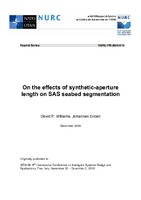| dc.contributor.author | Williams, David P. | |
| dc.contributor.author | Groen, Johannes | |
| dc.date.accessioned | 2018-10-11T14:09:41Z | |
| dc.date.available | 2018-10-11T14:09:41Z | |
| dc.date.issued | 2009/12 | |
| dc.identifier | 36673 | |
| dc.identifier.govdoc | NURC-PR-2009-018 | |
| dc.identifier.uri | http://hdl.handle.net/20.500.12489/658 | |
| dc.description.abstract | In this work, we quantify the relationship between synthetic-aperture length (or equivalently, along-track resolution) and seabed segmentation performance experimentally for real synthetic aperture sonar (SAS) imagery. The seabed segmentation algorithm employed uses waveletbased features, spectral clustering, and a variational Bayesian Gaussian mixture model. It is observed that for this approach, the correct seabed segmentation rate drops approximately ten percentage points for each halving of the along-track resolution between 3 cm and 96 cm. Moreover, changing the along-track resolution has the most significant effect on rocky seabeds. | |
| dc.format | 9 p. : ill. (digital, PDF file) | |
| dc.language | English | |
| dc.publisher | NURC | |
| dc.source | Originally published in: ISDA'09. 9th International Conference on Intelligent Systems Design and Applications, Pisa, Italy, November 30 - December 2, 2009. | |
| dc.subject | Synthetic Aperture Sonar (SAS) | |
| dc.subject | Sonar images | |
| dc.subject | Image processing | |
| dc.subject | Seafloor imaging | |
| dc.title | On the effects of synthetic-aperture length on SAS seabed segmentation | |
| dc.type | Reprint (PR) | |
| dc.type | Papers and Articles | |
